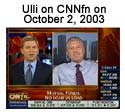MUTUAL FUND ARTICLES BY ULLI G. NIEMANN
Articles for Free publication in your Newsletter or on your
Website
Find a Methodology and Minimize Investment Madness
By Ulli G. Niemann
There are many reasons to be investing these days, and too
much opportunity to not have your money working for you.
However, I believe the majority of people dread having to
deal with investment matters, and tend to jump into purchases
and then hold their breath hoping for the best. After a long
day at work and taking care of the family, it's hard to get
excited about reading up on your 401(k) options, Morningstar
ratings and fund performances.
If this sounds like you, there are basically 3 choices.
1. You can have your investments
professionally managed,
2. you can continue as you
have in the past & keep your fingers crossed,
3. or you can find a methodology
that objectifies the investing process (that's buying and selling
investments) and helps you maximize your long-term results.
To determine if you need help managing your investments(and
this doesn't necessarily mean having to pay for advice) you
might want to ask yourself these questions:
If you're like most people, you would answer yes to some
and no to others, so how do you decide? If you think you
could have or should have done better with your investments,
then you need some help. Don't feel bad. Having counseled
hundreds of people over the past 15 years I can honestly
say that everybody needs some help, whether they are aware
of it or not.
Why? This could come as a surprise, but, in fact, your financial
life is a lot shorter than your physical life?
Most people who end up investing don't really start working
and making money until they are about 25 years old. Considering
the average retirement age of 65, this gives you only 40
years to save and invest wisely.
If you make a poor investment decision, such as trying to
stay fully invested during a bear market, you could lose
big both in terms of diminished dollars and wasted time.
To drive home this important point, let me give you an actual
example involving my own portfolio. For ease of illustration
I have adjusted the beginning portfolio balance to $10,000.
During the period from 1/25/91 to 10/13/00 my $10,000 investment
grew to $37,840, which is a 14.67% compounded annual return.
On 10/13/00, based on a methodology I was following, I liquidated
all of my domestic mutual fund positions and moved 100% to
the safety of my money market account. Thanks to this move,
my portfolio retained 100% of its value on that date.
As we now know with hindsight, most people held on to their
investment positions and have so far lost on average 50%
to 60% of the value of their portfolios. For this example
let us use 50%.
If I had held onto my position, my portfolio would be down
to $18,920. Last time I hit that level on the way up was
in 1995.
In other words, not only would I have lost 50% of my portfolio
I would have lost even more by having used up 20% (8 years)
of my total financial life.
How can you avoid mistakes like that in the future? Spend
a little of your valuable research time looking for investment
methodologies that allow you to side-step bear markets and
let you move back in during bull markets. In other words,
invest your time looking at methodologies instead
of investments themselves. This will lay the foundation for
more effective use of your money and time.
If you find a methodology that you like, and it matches
your investment philosophy, stick with it for the long term.
It should have the aspect of telling you when to get out
of, as well as when to get into, an investment.
I suggest you follow these broad guidelines:
If you take this advice, I guarantee that pretty soon sleepless
nights will be a thing of the past and you'll be on your
way to more confidently and successfully (that means profitably)
managing your investments.
© Ulli G. Niemann
Ulli
Niemann is an investment advisor and has been writing
about objective, methodical approaches to
investing for over 10 years. He eluded the
bear market of 2000 and has helped countless people make
better
investment decisions. To find out more about
his approach and his FREE Newsletter, please visit: www.successful-investment.com.
You have permission to publish this article electronically
or in print in your Newsletter, on your website,
or in your E-Book, as long as the author's Resource Box
is included with the article.










